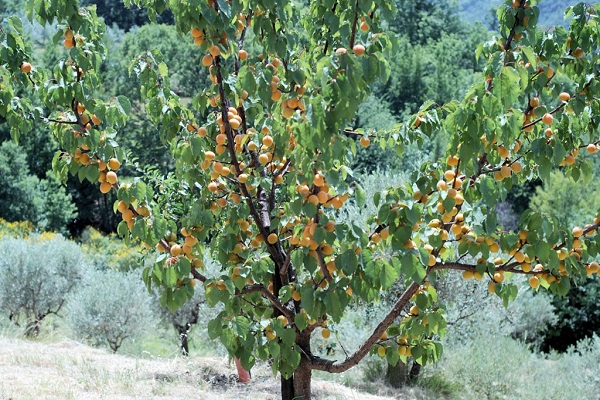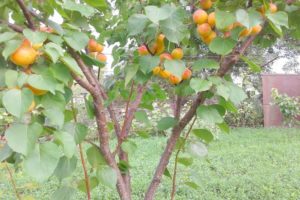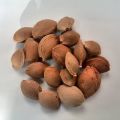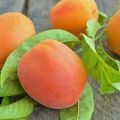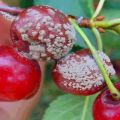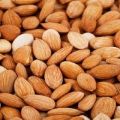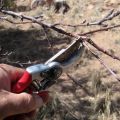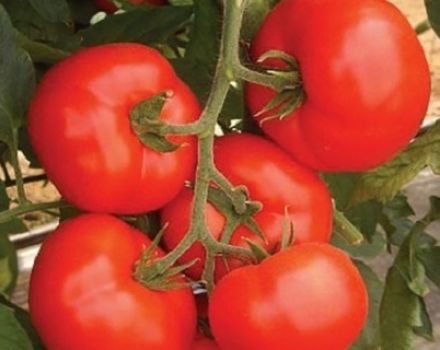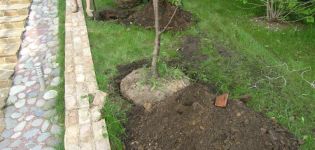What to do with gum disease and other diseases in apricot, treatment with chemicals and folk remedies
Many gardeners try to grow apricots on their backyards. The stone fruit culture is famous for the usefulness of its fruits and the versatility of their use. For a good yield of the harvest, it is important to know about the rules of care and understand what diseases of the apricot exist. Otherwise, you can not only not wait for the first fruits, but also lose the plant due to its death.
Content
The main causes of tree disease
There are quite a few causes of apricot diseases. All of them are associated with the influence of weather factors, improper care or a viral, bacterial or fungal disease. In case of health problems, the tree signals this with its appearance, abnormal changes appear on the trunks, fruits or leaves. By the symptoms, you can determine the nature of the apricot disease and the tactics of further action.

Timely correct processing is the key to a healthy garden
Apricots belong to the category of horticultural crops that are not able to regulate the volume of fruiting. Excessive weight of the branches leads to their breaking off, therefore, to exclude such a situation, spring pruning is required. The procedure is performed until the active start of the movement of juices and the formation of inflorescences. The autumn removal of branches has a right to exist, but at the same time, with the onset of early frosts, there is a risk that the plant will not have time to recover by this time and may die.
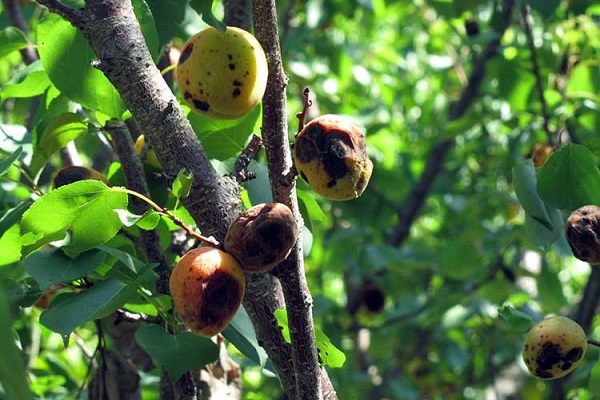
Improper treatment of fresh wounds leads to the fact that the apricot weakens and gum appears. The resin attracts harmful insects that can provoke viral diseases and further weaken the immunity of the fruit tree. To exclude such a situation, the wound is treated with a solution of copper sulfate and covered with garden varnish. When pruning, it is important to pre-sharpen and disinfect garden tools, which will not damage the bark and introduce infection.
Do not give up spring spraying. Chemical treatment will reduce the risk of contamination of the apricot at times. Modern products have a unique ability to simultaneously act against several types of pests, therefore, it is enough to carry out one spray to obtain effective plant protection. The apricot is processed immediately after cutting the crown, but until the wounds are covered.
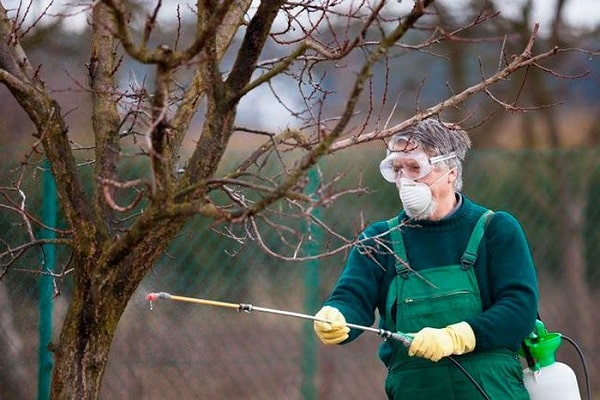
Diseases of seedlings and new shoots in the apricot tree and their treatment
Many factors influence the fruiting quality of a young apricot. It is important to choose the right variety and follow the planting rules.The tree does not like shaded and windy places, and thickening and high humidity increases the risk of fungal diseases.
On average, apricots begin to produce fruit after 3 years. Often the reason for the absence of fruits is the defeat of burn moniliosis, in which the inflorescences acquire a brown color and dry out.
To combat these and other types of fungal diseases, spraying with a solution of copper is carried out, most often Bordeaux liquid is used for these purposes.
The danger for young apricot seedlings comes not only from diseases of fungal and bacterial origin, but also from pests. The ovaries often suffer from the invasion of the moth, therefore, to combat them and other harmful insects, special chemicals are used, for example, "Horus".

Fungal and bacterial lesions. Ways to deal with them
Most often apricots attack fungal diseases, the risk of their occurrence in a young plant increases with high humidity and excessive rainfall. Diseases of apricots and their treatment depend on the nature of the lesion. Apricot leaves can affect black spots, pustules, plaques, signs of necrosis and other manifestations may appear, each of which indicates the presence of a certain disease and requires specific actions.
The means of combating apricot diseases is the observance of proper care and the implementation of preventive measures. A significant part of fungal and bacterial lesions is eliminated by spraying, which is carried out several times per season. In most cases, the first treatment is carried out before flowering, the second after its completion. Each subsequent one can be done every 14 days as needed.
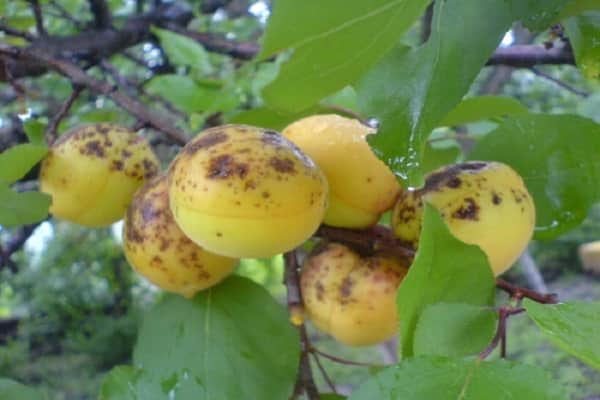
Curly leaves
Fungal disease of stone fruits is among the most common. The first sign is the appearance of red swollen formations on the leaves. Over time, the plates fold and twist. The fruits do not have time to ripen and die off, the appearance of the shoots is greatly modified. The disease can only be prevented by preventive measures. The fallen green mass should not be left to rot and it is required to spray with Bordeaux liquid in a timely manner.
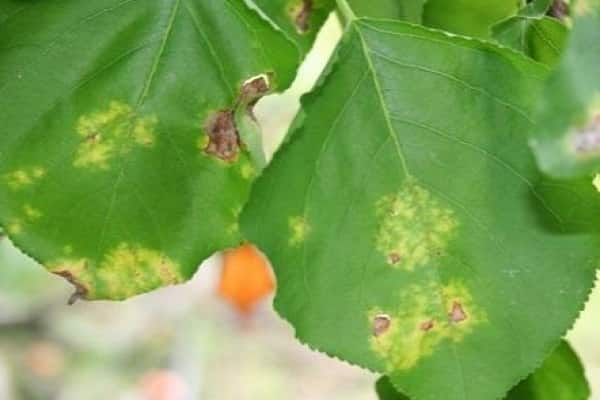
Gnomoniosis
The appearance of rot and yellow markings on the leaves may indicate a gnomoniosis infection. The leaf plates become reddish, turn brown and dry out. Apricots do not have time to fully grow, they strongly change their appearance and become "freaks". In some cases, they completely crumble before reaching the stage of maturity.
Folk remedies speak of the need to completely clean the affected area when the first signs of the disease are detected. The tree is sprayed with 1% solution of copper sulfate or Nitrafen. The spring treatment of apricot with Bordeaux liquid is a preventive measure.
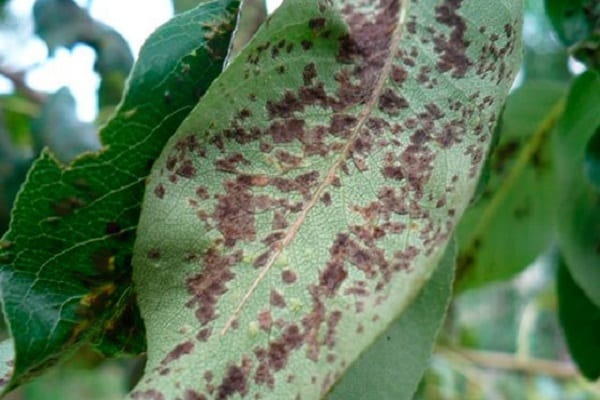
Coccomycosis
Apricot leaves, when affected by coccomycosis, are covered with reddish-brown spots. Over time, they grow and merge into a single whole, after which the greens dry up and fall off. With increased humidity, a plaque of fungal spores can form on the back of the leaves, which has a whitish or pink tint. The fruits may not fully ripen and become watery.
Unsightly spots appear on their surface, and the fruit loses its presentable appearance. The apricot pulp acquires an unpleasant flavor.
High temperature and high humidity contribute to the spread of the disease. Fungal spores are spread by rain and wind. The main way to combat coccomycosis is preventive gardening. The causative agent hibernates in leaves and gums, so in the fall, such residues are removed.In autumn, it is advisable to dig up the soil near the apricot. Timely pruning and crown formation work reduces the risk of disease.
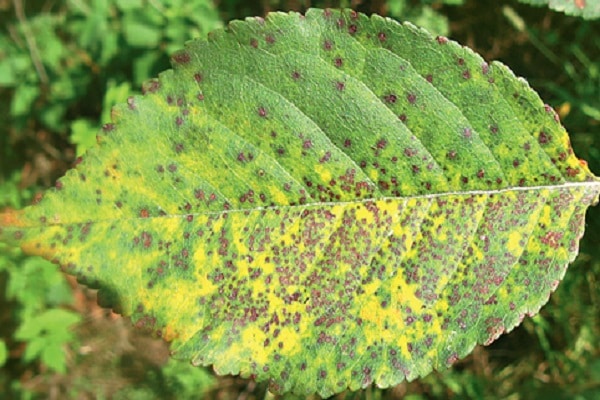
Clasteoporia
The fungal disease is activated immediately after flowering, as the pathogens hibernate in infected buds. Red dots on fruits and leaves are the first signs of an anomaly. Light brown spots of a rounded shape are formed on the greens, they look as if they have been pressed inward. The lesions lead to the loss of part of the leaf, therefore this apricot disease is often called perforated spot.
Apricot disease responds well to treatment in its initial stages. To do this, use "Poliram" or another targeted fungicide. A good means of preventing clotting disease is spraying with preparations containing copper.
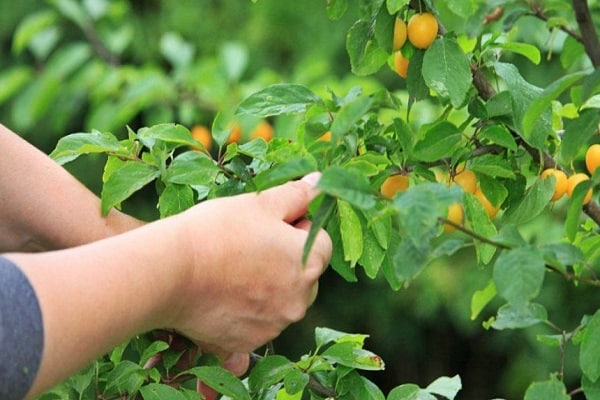
Leaf roll
The butterfly feeds on the leaves of fruit trees, which, after its visit, curl up into a tube. It is there that the insect prefers to hide from dangers. Caterpillars are famous for their speed of eating buds and leaves. In the summer, they turn into an adult butterfly, which lays eggs to form a new generation. Insects severely injure the apricot bark, causing the processes of gum removal. Caterpillars are harvested by hand, and apricots are sprayed with preparations - "Decis", "Inta-Vir".
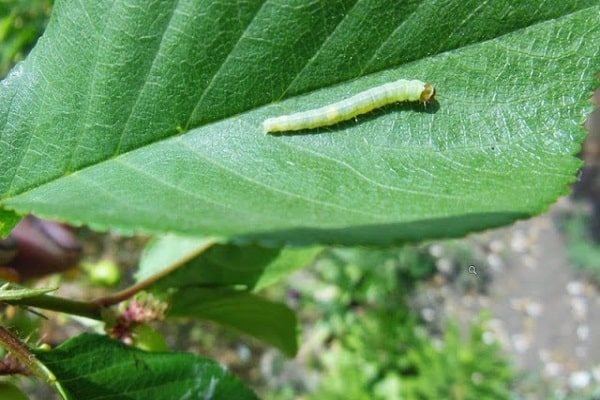
Scab
Fungal disease belongs to the category of the most common apricot diseases. The first symptoms of anomaly appear on the leaves of the plant, on which light round spots are formed. They are arranged in a chaotic manner and are located on the bottom surface of the plate. Over time, the speck begins to turn brown and spread, often covering the stalk. A large area of lesions leads to drying and leaf fall.
Brown spots transfer to shoots and are observed on the surface of the wood. Further, the same changes are demonstrated by fruits. On unripe fruits, they appear as gray or brown spots. As they ripen, the area of the foci grows, the surface of the apricots is covered with a velvety bloom, the color of which varies from olive to black. Further, there is cracking of the fruit and destruction of the pulp. Such fruits outwardly look ugly and rot during storage.

The reason for such a reaction of the apricot can be the stress of the fruit tree, the reaction to changes in the weather, such circumstances make it vulnerable to fungal infection. Fruits burst due to scab in high humidity or with sudden temperature changes in spring. An untimely performed preventive work or its incorrect implementation can lead to illness.
The causative agent of the disease is a fungus that hibernates in fallen leaves and fruits, so plant residues must be removed.
For the fight use fungicides of the latest generation - "Kaptan", "Topsin". Experienced gardeners, to eliminate the scab on the apricot, water and irrigate the crown with a mustard solution prepared from 40 g of powder and 5 liters of water. Some people use potassium permanganate for these purposes, while the liquid should be pink in color, since if the concentration of the drug is exceeded, apricot leaves can be burned.
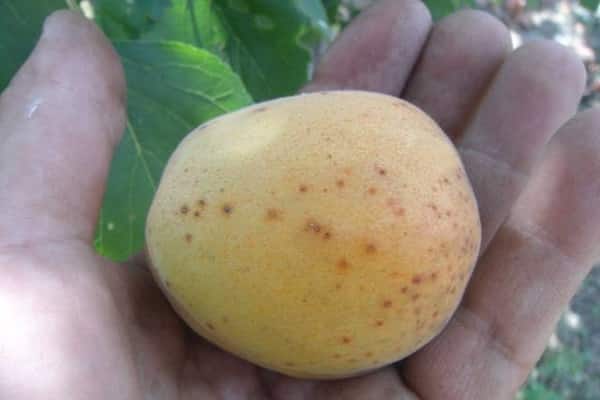
Moniliosis
If apricot leaves wilted after flowering and acquired a brown tint, then this may be the first sign of moniliosis. Further changes affect the fruits, which are covered with dark spots and begin to rot. The leaf plates are curled, and their appearance resembles the effects of exposure to fire.
In order to cure, the apricot is treated with Topsin, Topaz or Strobi. To prevent the appearance of the disease, preventive spraying in the spring with a 3% solution of Bordeaux liquid will help. In the fall, it is required to eliminate the remnants of foliage and damaged branches.
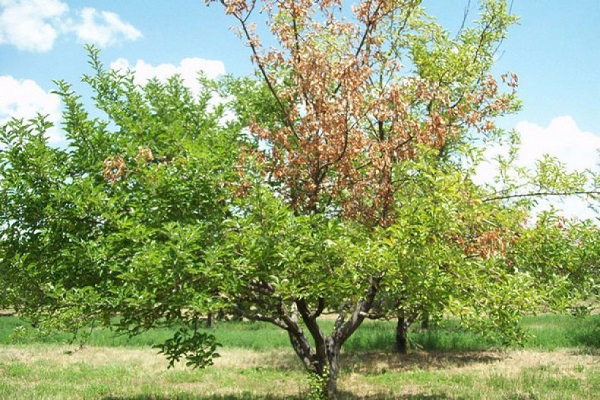
Vals fungus, verticillosis
The appearance of bright orange ulcers on the trunk indicates infection with the Vals fungus.The disease leads to damage to the wood, as a result of which the circulation of the sap is disturbed. The absence of waterlogging of the soil, regular pruning and treatment with fungicides at the first signs of fungus will help to get rid of the problem.
Apricot varieties are highly prone to verticillary wilt. The infected tree begins to lose its foliage at the beginning of summer, the greens before falling off turn yellow and dim. The ends of the branches become lifeless and dry out, changes from the edges begin to spread down to the center of the tree, over time, the shoots of the skeleton die.
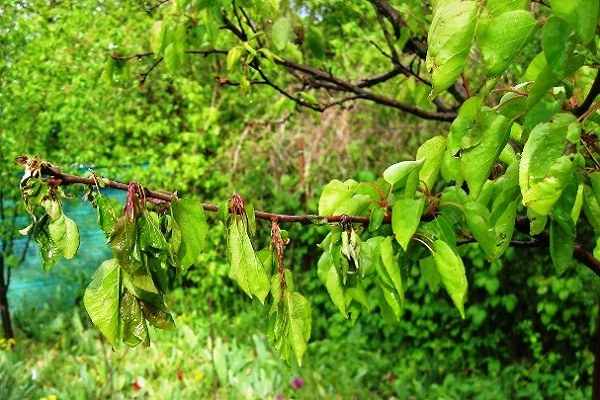
To accurately diagnose apricot disease, cut the wood and examine the appearance of its structure. The infected tree will have a speckled layer in cross-section, the specks being irregular in shape and in some cases capable of forming rings.
Verticillosis is difficult to diagnose and difficult to treat. The fungus is able to demonstrate expectant tactics for a long time, hibernate in fallen leaves and, when activated, completely spread through the tree. Preventive measures are the correct choice of the planting site; you should not place the apricot on the territory of the former presence of potatoes, tomatoes and strawberries. It is required to carry out preliminary fumigation or solarization of the soil.
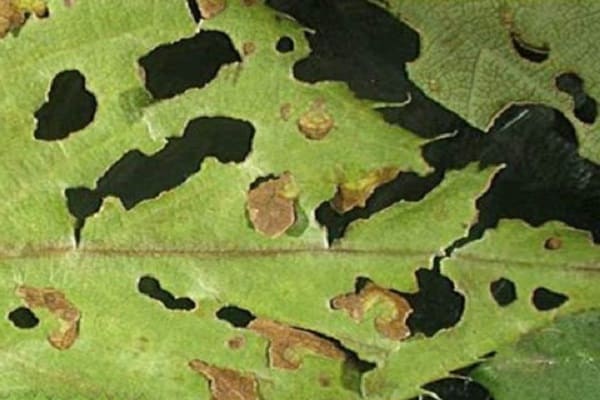
Cytosporosis
If the apricot leaves dry, then with a high degree of probability there has been an infection with cytosporosis. A fungal disease affects the wood of the trunk, localizing in places of damage and cuts. The first signs appear at the beginning of the summer period, when immediately after flowering, the apricot leaves begin to wither sharply, the process begins from the top of the tree, and changes are pronounced at the ends of young shoots.
The lesion is observed on the surface of the trunk and branches.
The disease of the bark looks like smudges of a brown hue, it becomes brown, a large number of cracks appear, from which gum oozes. Over time, the wood becomes covered with black bumps, which, after a year, transform into mushroom growths that have grown deep into the layers of the tree.
Apricot disease is treatable only at an early stage. To do this, remove the affected branches and foci, capturing 10 cm of a healthy area. The wound is treated with a solution of copper sulfate and covered with garden varnish. In the autumn period, phosphorus and potassium are added to the soil.
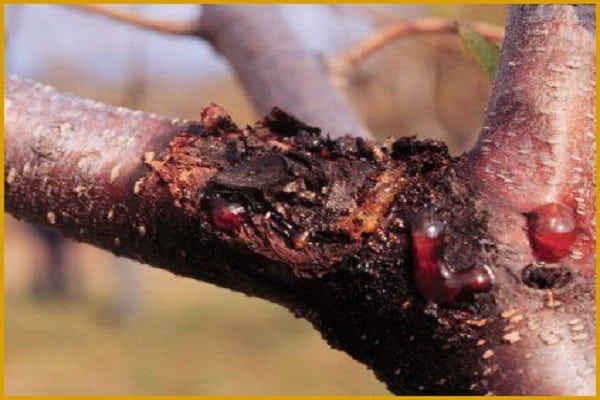
Fusarium
Damage to apricot health can be obtained from fungal pathogens at any time, but the risk of infection is higher during flowering. With fusarium, depressed brown spots appear on the leaves, gradually spreading to the fruits. The fruit pulp becomes dry and rotten, the skin shrivels.
The disease mainly affects weakened trees, shoots with signs of mechanical injuries. In order to combat infection, timely removal of branches, pruning, fertilizing and spraying with special preparations are carried out. The causative agent of fusarium lives in the soil, therefore, the fallen leaves and the remains of vegetation around the tree are removed.

Apricot gum removal
In case of gum removal, resin appears on the trunk of the apricot. The cause may be mechanical damage, a reaction to frost stress or sunburn. The disease causes weakening of the fruit tree and reduces the yield of its yield. The damaged area is cut out, treated with a solution of copper sulfate and "sealed" with garden varnish. It is not recommended to use products based on oil refined products to seal up cracks, as they are often harmful to humans and trees.

Pests and ways to protect against them
The list of apricot pests is quite diverse. The invasion of such insects leads to a weakening of the plant's immunity and a decrease in the quality of its fruiting.Weakened trees are more likely to be subject to various diseases and are less resistant to environmental factors.
Aphid
Numerous aphid infestations are usually observed until mid-summer. Pests settle on the back of the leaves and suck vital juices from the plant. Lack of nutrition adversely affects the growth of shoots and leads to their deformation. Aphids get rid of "Fitoverm" or "Fufanon".
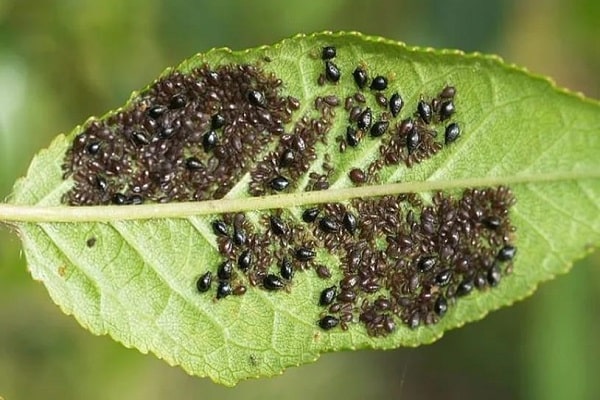
Fruit moth
Butterfly caterpillars appear towards the end of the summer period. They eat the fruits of apricot and go to the ground for wintering, often choosing for this the near-trunk territory or bark in the lower part of the tree. A solution of "Chlorophos" or "Entobacterin" saves from the moth.
Weevil
Small-sized beetles find apricot more often from other stone fruit crops. Pests feed on greenery, damage buds, inflorescences and fruits. With a large invasion of them, the tree can drop all the leaves in June. Insects wait out the winter in the bark or in the soil, so it is recommended to dig up the soil in the fall. To combat beetles, they carry out manual assembly and treatment with drugs - "Decis", "Kinmis".
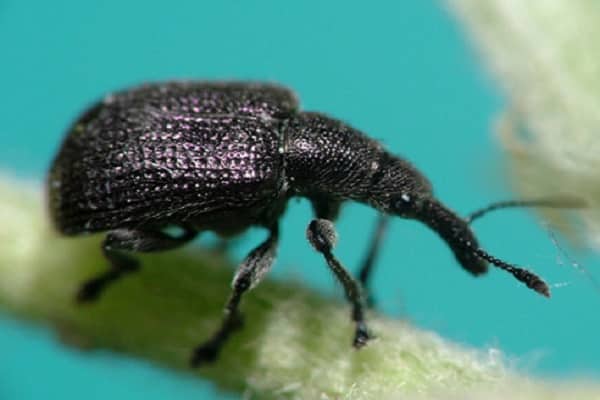
A set of preventive measures
To obtain a strong apricot and its good fruiting, it is important to observe a set of preventive measures. Key recommendations include:
- prevent waterlogging of the soil;
- pruning branches correctly and in a timely manner;
- remove damaged and diseased shoots, fallen leaves and fruits;
- monitor the growth of weeds around the base of the apricot, loosen the top layer of soil in the near-stem circle;
- control the moment the first signs of apricot disease appear, and if they are detected, immediately take action.
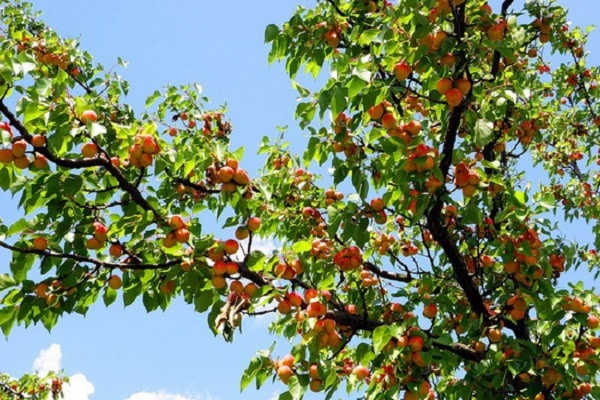
In the spring, for the purpose of prevention, the apricot tree is treated with 1% Bordeaux liquid. A good effect is shown by fumigating the shoots with sawdust. If pests or infection are detected, the plantings are treated with targeted chemicals.
To combat harmful insects, they carry out the autumn digging of the soil around the trunk of the apricot, since the larvae often choose such a place for wintering. Whitewashing of trunks is performed in autumn. For the fight, special types of insecticides are used.
